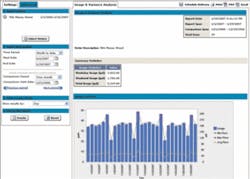Benefiting From Interval Meter Data
by Brian Fiut
About 75% of the earth’s surface is covered by water. For thousands of years, that water was enough to meet our needs and demands.
Today, a water provider taps into the source, typically an aquifer or reservoir, and pipes it to customers. Until now, the provider’s main concerns were building reservoirs to hold the water and the distribution system that carried the water from the source to the consumers. Often the customer’s bill had little to do with how much was actually consumed, but rather reflected the cost of delivering the water. In fact, estimated bills or flat-rate bills sent out quarterly or even annually are still commonplace in some areas.
Over the years, as they realized the need to quantify consumption, water providers metered their customers and bills began to reflect actual usage. Even then, limited access to meters often made reading them difficult; hence utilities would still bill customers quarterly and, in some cases, with estimated usage. Automated meter reading (AMR) has changed all of that. With AMR, utilities can easily collect a monthly read from the meter, using either a handheld or mobile collection system, and bill on a regular monthly basis. The difficulty and cost per meter read went down and cash flow went up.
The future will look a lot different. Today, only 0.3% of the earth’s water is clean enough to drink, and finite water supplies are the reality. With an ever-increasing demand for water against the backdrop of tighter supplies, water providers face a very different environment and need to account for every drop of water. More detailed data on water usage is a key piece to gaining visibility into where the water is going, who is using it, how much they are using and when they are using it.
Fixed network AMR systems allow water providers to collect and manage detailed meter data over a given time period, at intervals up to 15 minutes between readings. With a communications network throughout the service territory, water utilities are able to gather interval usage data on all of their customers without having to dispatch field service workers. Granular interval data, or data logging, enables a broad range of capabilities to help water providers manage the demand for water against supply and operational constraints.
Interval meter data is used to precisely monitor usage patterns and create usage profiles for every customer. These customer-specific profiles enable time-based rates programs, such as time-of-use billing. Charging higher water rates at specific times can influence customers’ usage behavior, thereby reducing the amount of consumption at determined periods to meet water management needs. Providing customers access to their usage data and associated pricing, through web presentment or an in-home display, enables them to make informed decisions concerning their consumption.
Time-based rates can also be used to lower a water providers electricity costs. Water utilities are often an energy provider’s largest customer and the recent adoption of peak pricing programs by some energy providers can adversely impact electricity expenses. Instituting time-based rates for water customers that correspond with energy peak pricing can encourage customers to lower consumption and the amount of water needing to be pumped and ultimately reduce the amount of electricity required for pumping water.
Utilities can also manage conservation programs with usage profiles. With interval data, a usage baseline can be created for the entire customer base or any specific group desired — subdivision, pressure zone, etc. Once the conservation program is implemented, current usage data is measured relative to the baseline for program effectiveness and customer compliance. Different programs, such as e-mail or door-hanger campaigns or different rate structures, can be tested against one another to determine the most effective implementations versus relative cost. Individual water savers and abusers can also be identified and tracked with their specific usage profiles.
Applying interval meter data to advanced engineering studies can optimize distribution system assets, resulting in the right-sizing of service lines and meters for long-term planning and for identifying assets that may be nearing their capacity design limits. Proactively managing water delivery systems can lead to the deferment of expensive capital investments and unpopular bond issues.
Although current water bills across the country are still relatively modest, leading industry experts predict that rates will increase significantly for the average consumer in the coming years. As the cost of water goes up, and water providers look for ways to balance demand and supply, interval meter data and time-based rates will be effective tools in modifying customer consumption behavior.
By 2025, it is predicted that water supplies will need to increase by 22% to meet the growing demand. Effective management of our existing water resources will be critical. Collecting and analyzing interval meter data will give water providers a better understanding into how water is used and transform that understanding into knowledge.
About the Author:
Brian Fiut is a senior product manager with Itron Inc. and is responsible for the Water Fixed Network 2.5 Solution, with emphasis on advanced meter data management. He has more than 20 years experience working in the communications and utility industries.


